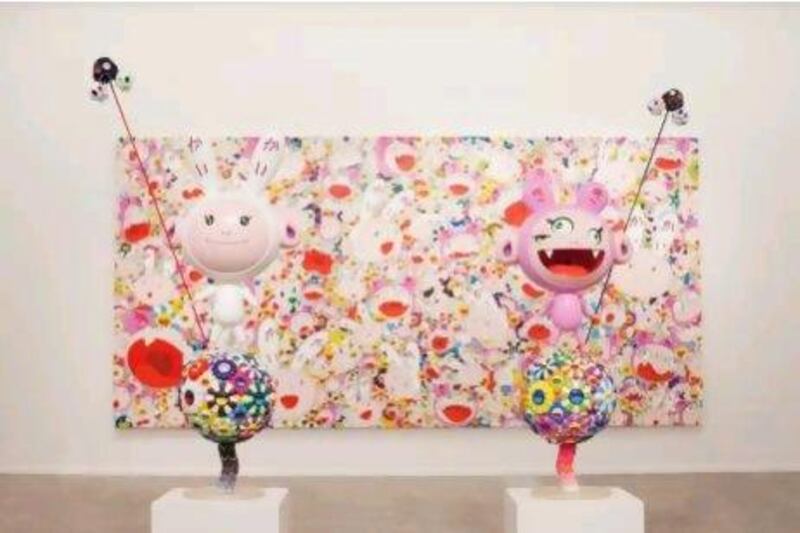Nothing says Ego quite like a six-metre-high inflatable structure of one's self.
Sitting crossed-legged in the entrance of Al Riwaq, Doha's warehouse-style art space, the giant Takashi Murakami looks down on visitors to the artist's first Middle East exhibition.
Dressed in a white T-shirt and shorts and sporting those famous round, silver framed glasses, the figure is one of 15 pieces produced by the 50-year-old Japanese artist for his Middle Eastern debut. The exhibition, which opened on Thursday, also contains more than 50 other examples of his work, dating as far back as 1997. These older pieces began arriving in Doha almost three months ago from international private and public collections.
"This show is in the Middle East, and the experience is my first time," he said ahead of the opening. "That is my motivation."
Murakami is well-known in the West's fashion, music and art worlds. His work is emblazoned across Louis Vuitton handbags as part of a six-year partnership that began in 2002 and helped to liven up the label, he designed Kanye West's third album cover (Graduation) in 2007 and made the video for his song Good Morning in the same year, and he continues to exhibit regularly at galleries and institutions in Europe and America.
Al Riwaq's galleries, where much of his art is now housed, form a world of supernatural fantasy. Psychedelic, colourful and happy images of hundreds of playful characters are presented in Murakami's signature style against dark, depressing and often terrifying backgrounds.
With a closer look, there's a deep message behind the colours, but one Murakami reckons might be truly understood only after he dies.
"I don't think while the artist is alive, there's much of a mission to art," he said. "It just looks like an illustration of cultural representation … In 150 years, you have a deeper perspective."
The scenes are surreal and easily identifiable as being rooted in anime.
"The reason why my art looks quintessentially Japanese is because I'm constantly trying to (make it that way)," he said. "I'm trying always to create something Japanese."
What follows is a collection of acrylic-on-canvas art works and installations, many featuring two large-eyed characters, Kaikai and Kiki. Kaikai Kiki is also the name of Murakami's own art-production company.
The final room provides sensory overload. Another character greets visitors; Tongari Kun (or Mr Pointy) stands tall at seven metres atop an LED-lit stage. Arhat Painting, one of the new pieces, stretches 100 metres, wrapping around three of the gallery's walls, and is the artist's largest painted work to date.
"It's exciting because this exhibition is a very different project," said Hoshino Sheisho, a painting director at Kaikai Kiki and one of around 200 people who worked on the piece. A studio was created specifically to make this painting, and was open 24 hours a day during busy periods. "Painting that was very difficult … it took six months to complete."
Two 12-metre Kaikai and Kiki balloons, previously used in the 2010 Macy's Thanksgiving Day parade, float above a circus-themed tent in which Murakami's motion graphic achievements are screened. More than 40 minutes of film clips he has worked on, from Kanye West's video to cartoon creations, play on repeat. Murakami, who spent almost two weeks finalising the exhibition, often slept in this dark and cosy room during the long working hours.
While Ego is a new chapter for Murakami and his team as they embrace a new region, it also marks another step by Qatar to try to become the region's hub for culture and art.
Talks between Murakami and the Qatar Museums Authority (QMA), chaired by Sheikha Al Mayassa bint Hamad bin Khalifa Al Thani, began two years ago when the artist visited. He took some persuading but agreed by March of last year when Qatar took the pressure off having him produce new pieces for the exhibition.
"I think he also thought 'we could do something here not many people can', because we have such a large space," said Jean Paul Engelen, the QMA's director of public art programmes.
By autumn of next year, the same space will be used for: Mal Lawal, where Qatar's local community will display their personal collections of artefacts, paintings and valuable objects; The Oriental Album of Bartholomäus Schachman, where more than 100 watercolour miniatures dramatising 16th-century life in Gdansk and Istanbul will be exhibited; Olympia: Myth-Cult-Games, a travelling showcase which tells the story of the Olympics from Athens to modern times; and Damien Hirst, which will feature the contemporary UK artist.
While the international media focuses obsessively on the royal family's acquisitions, most recently the reported record purchase of Paul Cézanne's The Card Players, the state is undeniably working hard to provide its citizens and guests with art to enjoy and take inspiration from.
This, it seems, also excites Murakami.
"The cultural breakthrough here will be accomplished by one or two people," he said. "People should break through and make changes, but how can it be accomplished? There are many younger artists drawn to my idea. They then have their own ideas.
"It's great I have this space. Beyond that, it's not the government or schools which will make a cultural breakthrough. It's going to be someone who is actually here and receiving the message."
Murakami may well be Qatar's greatest acquisition to date in this regard. If there is one artist now working who blurs the line between high and low art, gets people excited about it and simultaneously provides an entertaining experience, it is he.
Takashi Murakami's Ego by the Qatar Museums Authority will be exhibited at Al Riwaq until June 24





